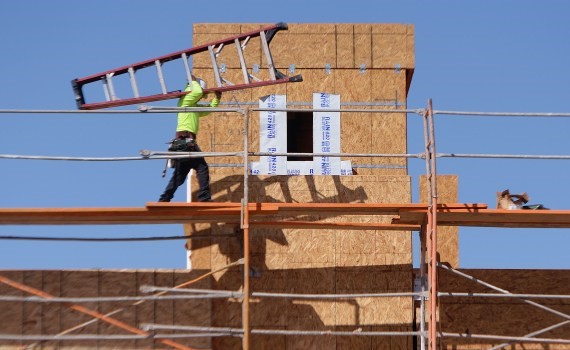
A construction crew member works on a townhome development on Redwood Boulevard near Wood Hollow Drive in Novato on Wednesday, Aug. 11, 2021. (Alan Dep/Marin Independent Journal)
By AMOS KLAUSNER
PUBLISHED: March 24, 2025
https://www.marinij.com/2025/03/24/marin-voice-state-housing-mandates-for-marin-dont-add-up/
Make no mistake, Marin County is undergoing radical change that will destroy many of the things we appreciate most about our communities.
I blame political know-it-alls in Sacramento, who are making it easier for developers to build oversized, out-of-character housing projects across our small cities and even smaller towns. This new class of unregulated development eschews local norms and local control, clashing with the culture that attracted us to the county in the first place.
Recent housing proposals include a 32-unit building in Tamalpais Valley; a 42-unit building in Marin City; an 80-unit development in Novato; a 99-unit building in Corte Madera; 16- and 13-story buildings in downtown San Rafael (with 165 and 189 units, respectively); a 243 unit building in Fairfax; and a colossal 1,422-unit development in Terra Linda. It’s just the tip of the iceberg in a climate where the affordable housing debate appears to have been hijacked by those hoping to circumvent planning commissions, whose role is to process community input and determine long-range planning goals.
Beyond the fact that developers seem to have little regard for how their projects will impact quality-of-life issues like traffic congestion or basic services like fire protection, the real culprit is the state.
In 2024 alone, Gov. Gavin Newsom signed over 60 housing-related bills into law. Many of them further erode local control and grease the wheels of development by speeding up approval processes, removing minimum parking requirements, allowing higher densities on smaller lots, and imposing civil penalties on communities that try to slow down development.
Since 1969, California’s Department of Housing and Community Development has required local governments to develop plans to meet housing numbers set by the state, not by local communities. This cyclical eight-year process is called the “regional housing needs allocation.” It is supposed to be based on demographic trends and housing conditions in each region.
For the current cycle running from 2023 to 2031, Marin County must add 14,405 units. In the previous cycle, which ran from 2015 to 2023, that number was 2,298. What’s changed to justify a 529% increase? You might assume that the demographic trends used to determine allocations have identified correlated population growth, but that isn’t the case.
In fact, between April of 2020 and December of 2023, Marin’s population decreased by 3.6%. For anyone convinced the drop was a brief hangover following the COVID-19 pandemic, California’s Department of Finance predicts population in Marin to remain flat between 2025 and 2070 (notwithstanding U.S. Census reports that showed a slight population increase of less than 1% between 2023 and 2024). Furthermore, officials predict a statewide increase of just over 2 million people during that same 45-year period. Regardless, the state mandated 2.5 million housing units for California in the current eight-year allocation cycle alone, when population is expected to increase by 700,000.
Affordable housing is an honorable goal. If the state focused allocations on that, our communities would be spared much of the negative change coming our way. Unfortunately, politicians on both sides of the aisle are using affordable housing to strip away local control and drive outsized housing development. And it makes sense if you follow the money. In 2021, the California Apartment Association, a landlord lobbying group, made campaign contributions to politicians and political committees in 51 of the state’s 58 counties.
The result is that only 45% of Marin’s allocation needs to be low-income units, while the rest are market rate. Still, developments in Marin are falling far short of the 45% target. The 243-unit project in Fairfax suggests 20% will be low income. In San Rafael, only 15% of units in a proposed 13-story building qualify and only 8% of units in a 16-story building. So how do they get away with it?
It all adds up to something rotten; politicians using affordable housing to pass laws that endanger our communities and open the flood gate to development – even though it doesn’t meet the intentions they used to justify their legislation in the first place.
Amos Klausner, of San Geronimo, is a member of the Marin County Committee on School District Organization.

